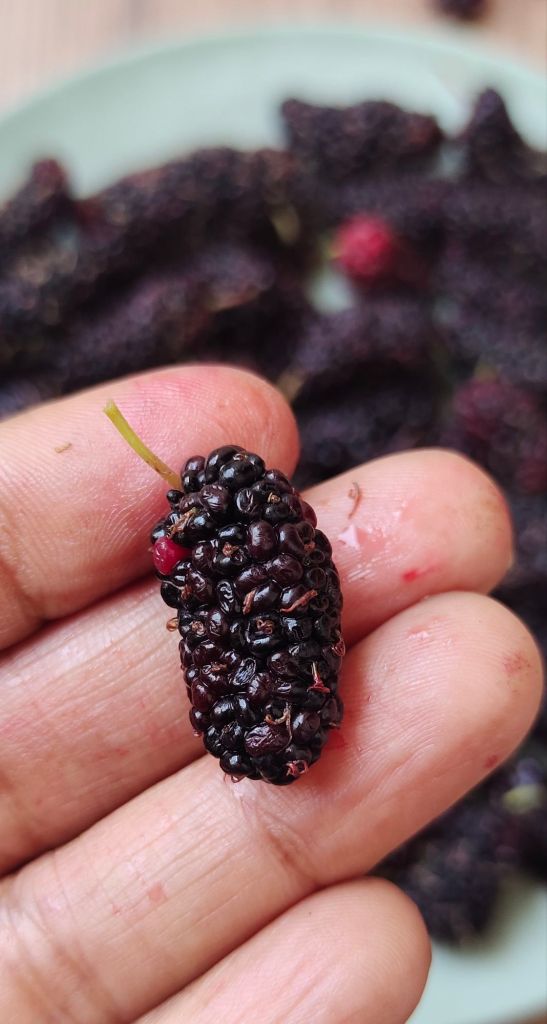Shahtoot Ki Chutney is a flavour-filled condiment made using mulberries. Sweet and sour and spicy, this chutney can light up any meal. Enjoy it as a side in a thali, or use it with rotis or parathas. It goes beautifully in wraps and sandwiches too. I think it makes for a lovely edible gift for close friends and family too!

I got my hands on the last of the summer’s mulberries recently, and this chutney happened. I made it North Indian-style, tempered with spices like saunf (fennel), kalonji (nigella seeds) and jeera (cumin), and it turned out so very lovely. The Shahtoot Ki Chutney was an instant hit with family, and disappeared soon after it was made. 🙂
I am sharing the recipe for Shahtoot Ki Chutney in today’s post, the way I made it. Do try it out whenever you have access to some fresh mulberries!
Ingredients Used In Shahtoot Ki Chutney
Mulberries (‘shahtoot‘ in Hindi) are the major ingredient used in this chutney. For the uninitiated, these berries are juicy and flavourful, sweet and slightly sour. They typically appear in the markets of India between March and May, and possess several health benefits. While mulberries can be eaten as is, they are also used in jams, chutneys, ice creams, salads, cakes and other baked goodies.

I used a few whole spices to temper the chutney – mustard, fennel, nigella seeds, fenugreek, cumin and dry red chillies. Apart from the usual salt, red chilli powder and turmeric, I also used jaggery and lemon juice to flavour the chutney.
I used regular refined oil for the tempering, but you can use mustard oil instead, too.

The mulberries I had were really sweet and not very sour, so I had to use very little jaggery and a dash of lemon juice to balance it all out – you can adjust these two ingredients depending upon how your mulberries taste.
Ingredients (serves 4-6):
1. 3 cups fresh mulberries
2. 1/2 tablespoon oil
3. 1/4 teaspoon black mustard seeds (kali sarson)
4. 1/4 teaspoon fennel seeds (saunf)
5. 1/8 teaspoon fenugreek seeds (methi dana)
6. 1/4 teaspoon nigella seeds (kalonji)
7. 1/4 teaspoon cumin seeds (jeera)
8. 2 dry red chillies (sookhi lal mirch), broken into halves
9. 2 pinches of asafoetida (hing)
10. Salt to taste
11. 1/2 teaspoon red chilli powder or to taste
12. 1/4 teaspoon turmeric powder
13. 1 tablespoon jaggery powder or to taste
14. A dash of lemon juice (optional)
Method:

1. Wash the mulberries well and place them in a strainer. Let all the water drain out. Now, remove the stems from the mulberries. Chop them up roughly. Keep ready.
2. Heat oil in a heavy-bottomed pan. Add in the mustard seeds, and allow them to sputter. Then, add in the fennel seeds, fenugreek, kalonji, cumin, dry red chillies (broken into two), and asafoetida. Allow them to stay in for a couple of seconds, taking care to ensure that the ingredients do not burn.
3. Now, add the chopped mulberries to the pan, followed by salt and turmeric powder. Reduce the flame down to medium. Mix well.
4. Cook the mixture on medium heat for 3-4 minutes or till the mulberries start disintegrating and turning soft. Stir intermittently.

5. At this stage, add in the red chilli powder and jaggery powder. Mix well.
6. Continue to keep the flame at medium, and keep cooking till the mixture becomes jammy in consistency. This might take 4-5 minutes more. Switch off gas at this stage. You will need to stir intermittently.
7. Add lemon juice to taste at this stage, if required. Mix well. Your Shahtoot Ki Chutney is ready. Allow the chutney to cool down completely, then transfer it to a clean, dry, air-tight bottle. Store refrigerated and use as needed.
Tips & Tricks
- Use a heavy-bottomed pan to cook the chutney. Make sure you cook on medium flame, to prevent burning and sticking to the bottom of the pan.
- You can use sugar in place of the jaggery I have used here.
- I have used a few whole spices – like fennel, nigella, cumin and mustard – in the tempering. If you have panch phoron, the quintessential Bengali spice mix, you can use it for tempering instead of adding these whole spices individually + the asafoetida and dry red chillies.
- Cook the chutney till it thickens and gets a glossy look. However, do not overcook it as it can become hard. Remember that it thickens up further with time.
- Like I was saying earlier, the mulberries I had (sourced from Trikaya, online) were really sweet and not very sour. So, I had to use very little jaggery and a dash of lemon juice. Please adjust the quantity of jaggery and lemon juice depending upon the taste of the berries you use.
- Adjust salt and red chilli powder as per personal taste preferences.
- I have used regular refined oil here, in very little quantity. You may use mustard oil, if you prefer it. Adjust quantity as per personal preferences.
- Take care to ensure that the whole spices do not burn while tempering.
- Ideally, do not add any water while cooking the chutney, to improve its shelf life.
- Once completely cool, you can transfer the Shahtoot Ki Chutney to a clean, dry, air-tight bottle and store it refrigerated. It stays well for 7-10 days this way.
Did you like this recipe? Do tell me, in your comments!